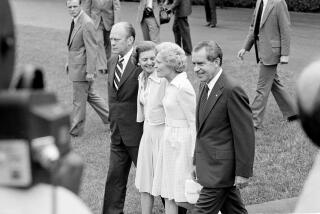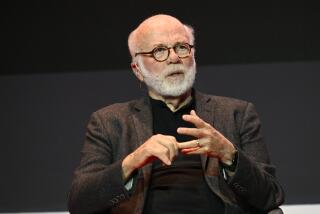Henry Ford II Is Dead at 70 : Rescued Firm at Urging of F.D.R. in ’45
- Share via
DETROIT — Henry Ford II, who took over his grandfather’s foundering company at President Franklin D. Roosevelt’s urging in 1945 and over 37 years restored Ford Motor Co. to profitability, died today after a battle with pneumonia. He was 70.
Ford had been admitted to Henry Ford Hospital on Sept. 12 for treatment of pneumonia, but his condition had deteriorated as he developed heart and kidney problems. He had become ill while in Europe.
During his tenure, Ford won recognition for his advocacy of corporate contributions to social progress, for his backing of Detroit’s Renaissance Center and for his tempestuous dealings with such corporate lieutenants as Lee Iacocca, whom he fired as company president in 1978.
Put Past Aside
Iacocca put aside the past in lauding Ford in a statement.
“Our industry, and all of American business, has lost a true leader. His vision and hard work transformed Ford into a great company, but he will be remembered as well for his many civic contributions.
“Henry Ford and I were friends and colleagues for a lot longer than we were adversaries, and my sympathy goes to his family and friends,” Iacocca said.
General Motors Corp. Chairman Roger B. Smith also mourned Ford’s passing.
“All of us at General Motors are saddened by the death of Henry Ford II. With his passing, the auto industry has lost a legend as well as a leader,” Smith said in a statement.
For its part, the company under Ford enjoyed some notable successes, including the Mustang, and suffered a notable bomb, the Edsel. Henry Ford II turned over the chairmanship of the company to a non-family member as it began a retrenchment to counter foreign competition but remained on the board of directors and as chairman of the finance committee.
Oldest Child of Edsel Ford
He was born Sept. 4, 1917, in Detroit, the oldest of four children of Edsel Ford and Eleanor Clay Ford. He graduated in 1936 from Hotchkiss School in Lakeville, Conn., and attended Yale University but did not graduate.
Edsel, the elder Henry Ford’s only child, took over the presidency of the auto maker in 1919, and died in 1943. The senior Ford resumed the post.
In 1944, when young Henry Ford was an officer in the U.S. Navy, Roosevelt became alarmed that the auto maker would collapse because of mismanagement by its aging founder. The government allowed the officer to return home.
Ford II was just 28 in 1945 when, upon the retirement of his grandfather, he maneuvered Harry Bennett away from inheriting the presidency over some opposition from the old man, who died two years later.
Rescued Company
He then set about rescuing a company eclipsed about 15 years earlier by General Motors as the world’s largest auto maker.
Ford began reorganizing the company in 1944 while executive vice president. In July, 1945, Ford Motor became the first manufacturer to exhibit a 1946 model car, but it lost $8 million in 1946.
Ford by then had launched a multibillion-dollar, international reorganization and expansion program that resulted by 1955 in a net profit of about $430 million. Ford went public the following year with the sale of 10.2 million shares, although holders of Ford Class B stock, most of them Ford family members, continue to control 40% of the general voting power.
He recruited a management team of young Army Air Corps officers dubbed the “Whiz Kids” as they revived Ford Motor’s fortunes in the booming postwar market.
They included Robert S. McNamara, later secretary of defense under Presidents John F. Kennedy and Lyndon B. Johnson; Charles Thornton, who later headed Litton Industries, and Arjay Miller, who along with McNamara also served as president of Ford Motor when Ford II left that post in July, 1960, to become board chairman.
Iacocca, whose ascent in the company resulted largely from his leadership in developing the Mustang, the Continental Mark III and the Maverick, was fired as president in 1978, with Ford explaining, “Well, sometimes you just don’t like somebody.” Iacocca, aided by top managers he hired away from Ford, went on to bring Chrysler Corp. back from the brink of bankruptcy.
Ford remained chairman until March 13, 1980, when he was succeeded by Philip Caldwell, the first non-member of the Ford family to hold the post of chief executive officer. He retired from the company on Oct. 1, 1982.
“What I saw of him, and I only saw one side of him, was a civil man, deeply involved with many community activities,” Douglas Fraser, former president of the United Auto Workers union, said of Ford in 1986.
“The Renaissance Center simply would not exist without him,” Fraser said. “He was the moving force that put pressure on other people.”
The Renaissance Center, a landmark high-rise downtown Detroit office, retail and hotel complex backed by a Ford Motor development subsidiary, was completed in 1977.
Ford, a resident of Palm Beach, Fla., also maintained a home in Grosse Pointe Farms, Mich., and an estate at Henley-on-Thames, England, outside London.
Ford and his first wife, Anne McDonnell, whom he married in 1940, had three children, Edsel II, Charlotte and Anne.
His 1964 divorce from her resulted in his excommunication from the Roman Catholic Church, to which he converted when they married.
Ford was married from 1965 to 1980 to the former Maria Cristina Vettore Austin; that marriage also ended in divorce. He married Kathleen DuRoss in 1980.
More to Read
Inside the business of entertainment
The Wide Shot brings you news, analysis and insights on everything from streaming wars to production — and what it all means for the future.
You may occasionally receive promotional content from the Los Angeles Times.










